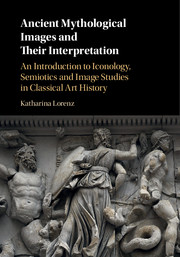 Ancient Mythological Images and their Interpretation
Ancient Mythological Images and their Interpretation 2 - Iconology in action
from ICONOLOGY
Published online by Cambridge University Press: 05 August 2016
Summary
The analysis here proceeds in two stages that encompass the Panofskyan three-step model. At the iconographic stage, the focus is first on the depicted characters, their attire, and their relation to each other and to other pictorial elements, and then, in a second step, these elements are compared with other visual and textual versions of the myth. At the iconological stage, the specific rendering of the mythological story as presented in the pictures is contextualised within its historical setting.
The Karlsruhe hydria: conflict, consolation, and Athens
An iconographic analysis.
The figure of the Trojan prince Paris (Alexandros) in the upper picture field, the character judging over the fairest of the Olympian goddesses, is at the centre of the hydria's iconographic peculiarities requiring explanation (fig. 0.1). He is dressed in Oriental clothes, with soft cap, richly patterned tunic and trousers, and with a dagger featuring a bird's head hilt hanging from a baldric across his upper body. The lagobolon, a hunting utensil, in his left hand identifies him as a figure of the outdoors and as a shepherd, as do also the landscape setting and the dog at his feet.
The picture's nucleus shows Paris in negotiation with Hermes and Eros (fig. 5.1). The prince's hand gesture towards Eros, with thumb and index finger of the right meeting, seemingly expresses approval. The three goddesses are arranged around this group. Athena is on the left in full armour, including an Attic helmet with horse protomes and the aegis. The woman standing further to the left is Hera, here lifting her garment in a way reminiscent of the aidos motif. Aphrodite, in contrast, is depicted seated towards the right of the nucleus; she is accompanied by another Eros, who mimics the stance of the Eros standing next to Paris.
The scene on the Karlsruhe hydria differs in two aspects from earlier representations of the Judgement, which enjoyed considerable popularity in sixth- and fifth-century black- and red-figure Athenian vase-painting. The first contrast concerns the characterisation of the participants, their appearance, and their actions. In archaic and early classical versions, the three goddesses were distinguished, if at all, by their attributes.
- Type
- Chapter
- Information
- Ancient Mythological Images and their InterpretationAn Introduction to Iconology, Semiotics and Image Studies in Classical Art History, pp. 37 - 88Publisher: Cambridge University PressPrint publication year: 2016


